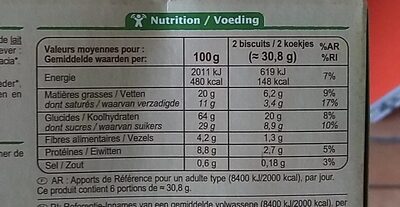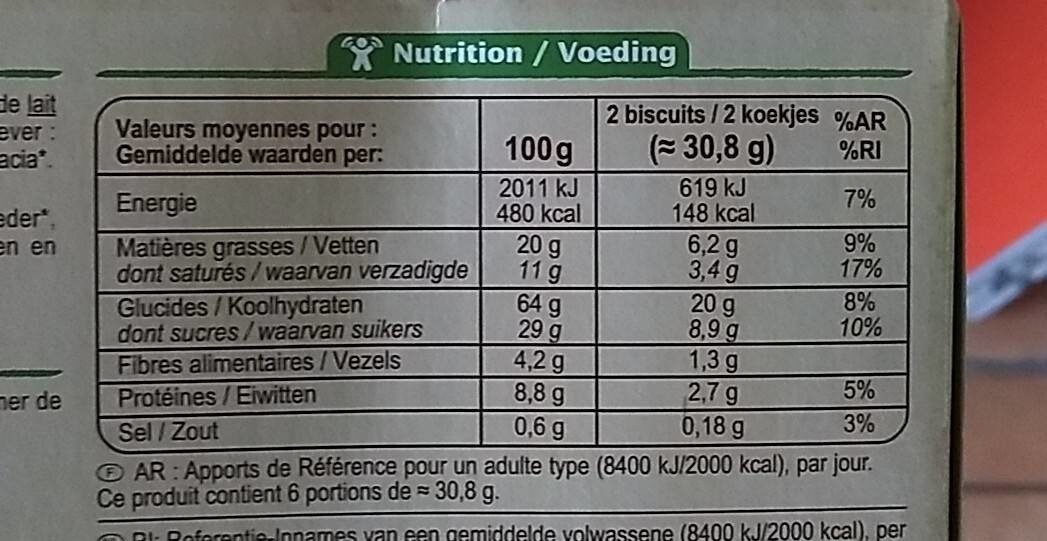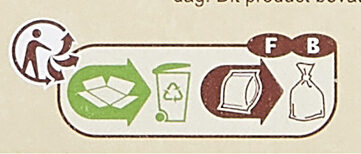Fourrés au cacao - Carrefour Bio - 185 g
Aquesta pàgina del producte no està completa. Podeu ajudar a completar-la editant-la i afegint-hi més dades a partir de les fotos ja disponibles, o fent-ne més amb l'aplicació de androide o iPhone / iPad. Gràcies!
×
Algunes de les dades d’aquest producte les ha proporcionat directament el fabricant Carrefour.
Codi de barres: 3270190182160 (EAN / EAN-13)
Nom comú: Biscuits fourrés au chocolat
Quantitat: 185 g
Empaquetament: Cartó, fr:Film plastique
Marques: Carrefour Bio, Carrefour
Categories: Snacks, Aperitius dolços, Galetes i pastissos, Galetes, Galetes de xocolata, en:Filled biscuits
Etiquetes, certificacions, premis:
Orgànic, Orgànic UE, Agricultura UE, FR-BIO-01, Fet a França, Lliure d'oli de palma, AB Agriculture Biologique, fr:Agricultura UE, fr:Agricultura UE/no UE, fr:Agricultura no UE, fr:Ecológico, fr:Ecológico UE, fr:Hecho en Francia

Llocs de fabricació o processament: BOUVARD BISCUITS S.A.
Codi de traçabilitat: EMB 39113 - Chassal (Jura, France)
Enllaç a la pàgina del producte en el lloc oficial del productor: http://courses.carrefour.fr/drive/tous-l...
Botigues: Carrefour, carrefour.fr
Països on es va vendre: França, Itàlia, Espanya, fr:Francia
Matching with your preferences
Altres dades
Condicions de conservació: À conserver à l'abri de la chaleur et de l'humidité. Pour une dégustation optimale, à consommer de préférence avant le : voir sur le côté de l'étui.
Servei al client: Interdis - TSA 91431 - 91343 MASSY Cedex - France
Report a problem
Fonts de dades
Producte afegit per pierrekilly
Última modificació de la pàgina del producte per scanbot.
La pàgina del producte, també editada per beniben, bobobeauvais, desan, driveoff, ecoscore-impact-estimator, emmanuelduacap, hhassan, inf, jcr83, kiliweb, openfoodfacts-contributors, org-carrefour, packbot, quechoisir, roboto-app, segundo, tacite, teolemon, thaialagata, yuka.C5ZtLN6PI-99HfWJ0LgW_yOANMbBL-MCA0Ewog, yuka.SEtzTVFLOERwYWc2aS9JNDd6cjZwWU5WK2NXMFJGK3JkdEFBSVE9PQ, yuka.WW9VeUxKd0NpTXNRa2NReDJUTDgvZjVFMmEvMUJtTzdHZHNLSWc9PQ, yuka.WktNU05Qc01tK0l3cWZZVjhoYjAwNGxVbnJLcmNsbWFMTTBmSVE9PQ, yuka.Ylk4NUFJRWZpYUVRdXNRN3owN3QyT3QvbTcrcVVsS1NLclVKSWc9PQ, yuka.ZmFzL0xwVXhxdjBUcFAwMXhoangrKzF4MTUrT1RINmRKYklOSWc9PQ, yuka.ZmZ3YUthMGVnZlkzeXZNaXB4YkV4NGxuM2NiM1pVeUpOTkZBSUE9PQ, yuka.sY2b0xO6T85zoF3NwEKvllVaf-HcnG_EbzLhnkO6yMjSLK7jaPUr65WmAas, yuka.sY2b0xO6T85zoF3NwEKvlmliXIvUs2_8JwTks0mHwfGSJ6f5c-B4_bL2Eas, yuka.sY2b0xO6T85zoF3NwEKvln1YSYbVgg_dBRDfu26W6oaFdYK5OMhX_4noDqs.














